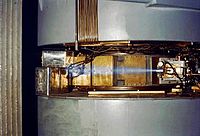
Photo from wikipedia
Electromagnetic ion cyclotron waves are expected to pitch-angle scatter and cause atmospheric precipitation of relativistic (>1 MeV) electrons under typical conditions in Earth's radiation belts. However, it has been a long-standing… Click to show full abstract
Electromagnetic ion cyclotron waves are expected to pitch-angle scatter and cause atmospheric precipitation of relativistic (>1 MeV) electrons under typical conditions in Earth's radiation belts. However, it has been a long-standing mystery how relativistic electrons in the hundreds of keV range (but <1 MeV), which are not resonant with these waves, precipitate simultaneously with those >1 MeV. We demonstrate that, when the wave packets are short, nonresonant interactions enable such scattering of hundred-keV electrons by introducing a spread in wave number space. We generalize the quasilinear diffusion model to include nonresonant effects. The resultant model exhibits an exponential decay of the scattering rates extending below the minimum resonant energy depending on the shortness of the wave packets. This generalized model naturally explains observed nonresonant electron precipitation in the hundreds of keV concurrent with >1 MeV precipitation.
Journal Title: Physical review letters
Year Published: 2022
Link to full text (if available)
Share on Social Media: Sign Up to like & get
recommendations!